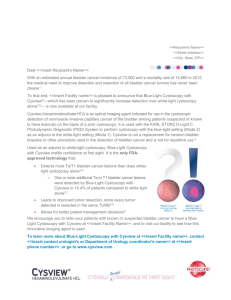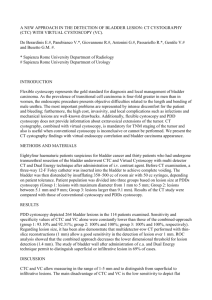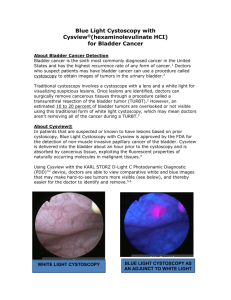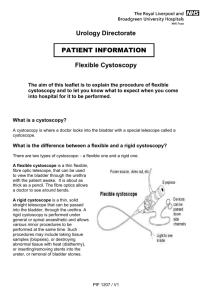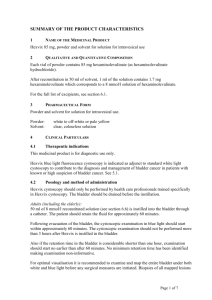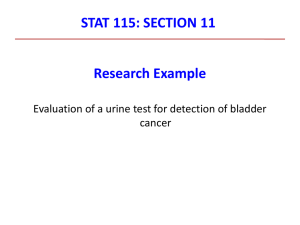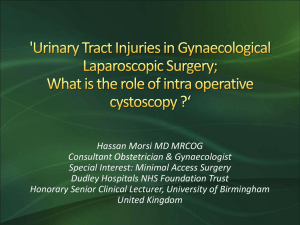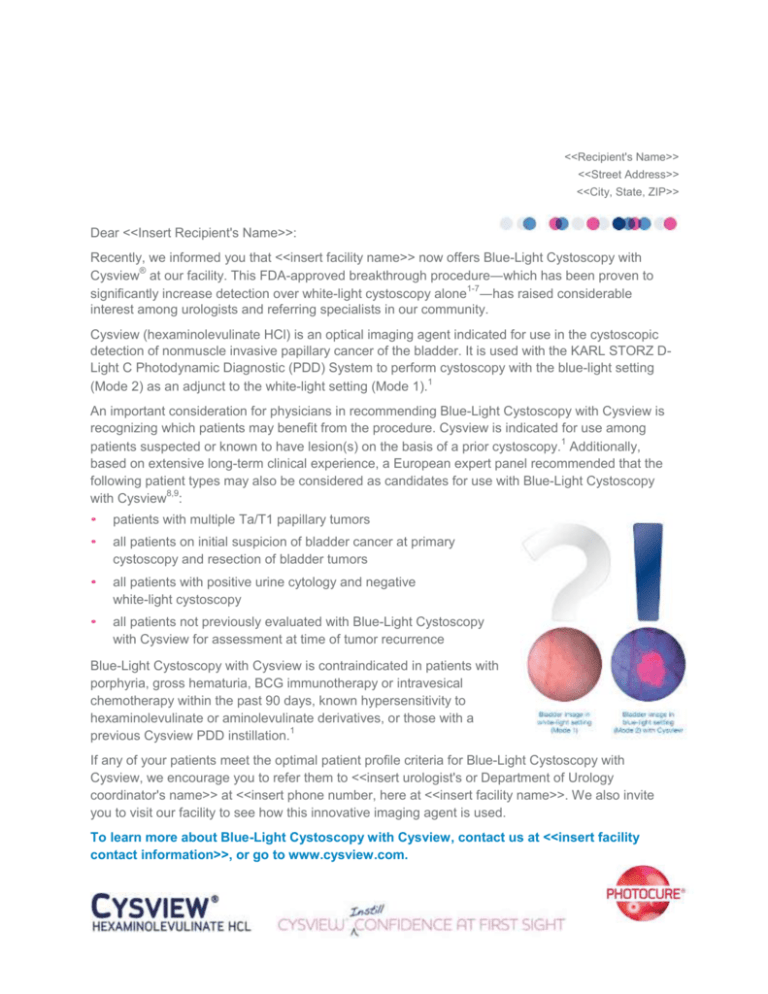
<<Recipient's Name>>
<<Street Address>>
<<City, State, ZIP>>
Dear <<Insert Recipient's Name>>:
Recently, we informed you that <<insert facility name>> now offers Blue-Light Cystoscopy with
Cysview® at our facility. This FDA-approved breakthrough procedure―which has been proven to
significantly increase detection over white-light cystoscopy alone1-7―has raised considerable
interest among urologists and referring specialists in our community.
Cysview (hexaminolevulinate HCl) is an optical imaging agent indicated for use in the cystoscopic
detection of nonmuscle invasive papillary cancer of the bladder. It is used with the KARL STORZ DLight C Photodynamic Diagnostic (PDD) System to perform cystoscopy with the blue-light setting
(Mode 2) as an adjunct to the white-light setting (Mode 1).1
An important consideration for physicians in recommending Blue-Light Cystoscopy with Cysview is
recognizing which patients may benefit from the procedure. Cysview is indicated for use among
patients suspected or known to have lesion(s) on the basis of a prior cystoscopy.1 Additionally,
based on extensive long-term clinical experience, a European expert panel recommended that the
following patient types may also be considered as candidates for use with Blue-Light Cystoscopy
with Cysview8,9:
•
patients with multiple Ta/T1 papillary tumors
•
all patients on initial suspicion of bladder cancer at primary
cystoscopy and resection of bladder tumors
•
all patients with positive urine cytology and negative
white-light cystoscopy
•
all patients not previously evaluated with Blue-Light Cystoscopy
with Cysview for assessment at time of tumor recurrence
Blue-Light Cystoscopy with Cysview is contraindicated in patients with
porphyria, gross hematuria, BCG immunotherapy or intravesical
chemotherapy within the past 90 days, known hypersensitivity to
hexaminolevulinate or aminolevulinate derivatives, or those with a
previous Cysview PDD instillation.1
If any of your patients meet the optimal patient profile criteria for Blue-Light Cystoscopy with
Cysview, we encourage you to refer them to <<insert urologist's or Department of Urology
coordinator's name>> at <<insert phone number, here at <<insert facility name>>. We also invite
you to visit our facility to see how this innovative imaging agent is used.
To learn more about Blue-Light Cystoscopy with Cysview, contact us at <<insert facility
contact information>>, or go to www.cysview.com.
Important Risk and Safety Information
Cysview is not a replacement for random bladder biopsies or other procedures used in the detection of bladder cancer
and is not for repetitive use.
Anaphylaxis reactions including anaphylactoid shock, hypersensitivity reactions, bladder pain, cystitis, and abnormal
urinalysis have been reported after administration of Cysview. The most common adverse reactions seen in clinical
trials were bladder spasm, dysuria, hematuria, and bladder pain.
Cysview should not be used in patients with porphyria, gross hematuria, or with known hypersensitivity to
hexaminolevulinate, or in patients receiving intravesical chemotherapy or BCG treatment within 3 months of
Cysview photodynamic blue-light cystoscopy. There are no known drug interactions with hexaminolevulinate;
however, no specific drug interaction studies have been performed. Using Cysview, fluorescence of non-malignant
areas may occur, and Cysview may fail to detect some malignant lesions.
Safety and effectiveness have not been established in pediatric patients. Cysview should only be used during
pregnancy if the potential benefit justifies the potential risk to the fetus. It is not known whether hexaminolevulinate
is excreted in human milk. Because many drugs are excreted in human milk, exercise caution when Cysview is
administered to nursing mothers. No clinically important differences in safety or efficacy have been observed
between older and younger patients.
Cysview is approved for use with the Karl Storz D-Light C Photodynamic Diagnostic (PDD) system. For system set
up and general information for the safe use of the PDD system, please refer to the Karl Storz instruction manuals for
each of the components.
Prior to Cysview administration, read the Full Prescribing Information and follow the preparation and reconstitution
instructions.
References: 1. Cysview [prescribing information]. Princeton, NJ: Photocure ASA; 2011. 2. Schmidbauer J, Witjes F, Schmeller N, et al. Improved
detection of urothelial carcinoma in situ with hexaminolevulinate fluorescence cystoscopy. J Urol. 2004;171(1):135-138. 3. Grossman HB, Gomella L,
Fradet Y, et al. A phase III, multicenter comparison of hexaminolevulinate fluorescence cystoscopy and white light cystoscopy for the detection of
superficial papillary lesions in patients with bladder cancer. J Urol. 2007;178(1):62-67. 4. Fradet Y, Grossman HB, Gomella L, et al. A comparison of
hexaminolevulinate fluorescence cystoscopy and white light cystoscopy for the detection of carcinoma in situ in patients with bladder cancer: a phase
III, multicenter study. J Urol. 2007;178(1):68-73. 5. Jocham D, Witjes F, Wagner S, et al. Improved detection and treatment of bladder cancer using
hexaminolevulinate imaging: a prospective, phase III multicenter study. J Urol. 2005;174(3):862-866. 6. Stenzl A, Burger M, Fradet Y, et al.
Hexaminolevulinate guided fluorescence cystoscopy reduces recurrence in patients with nonmuscle invasive bladder cancer. J Urol.
2010;184(5):1907-1913. 7. Hermann GG, Mogensen K, Carlsson S, Marcussen N, Duun S. Fluorescence-guided transurethral resection of bladder
tumours reduces bladder tumour recurrence due to less residual tumour tissue in Ta/T1 patients: a randomized two-centre study. BJU Int. 2011;108(8
pt 2):E297-303. 8. Witjes JA, Redorta JP, Jacqmin D, et al. Hexaminolevulinate-guided fluorescence cystoscopy in the diagnosis and follow-up of
patients with non–muscle-invasive bladder cancer: review of the evidence and recommendations. Eur Urol. 2010;57(4):607-614. 9. Mark JR, GelpiHammerschmidt F, Trabulsi EJ, et al. “Blue light” cystoscopy for detection and treatment of non-muscle invasive bladder cancer. Can J Urol.
2012;19(2):6227-6231.
© 2012 Photocure Inc. All rights reserved.
Cysview is a registered trademark of Photocure ASA.
August 2012 CYSC2012029A


